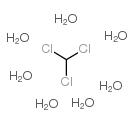10025-90-8
| Name | praseodymium(3+),trichloride,heptahydrate |
|---|---|
| Synonyms |
PRASEODYMIUM CHLORIDE HEPTAHYDRATE
PRASEODYMIUM CHLORIDE HYDRATE praseodymiumchlorideheptahydrate99.9 PRASEODYMIUM CHLORIDE,HYDROUS |
| Density | 2.25 g/cm3 |
|---|---|
| Melting Point | 115ºC |
| Molecular Formula | CH15Cl3O7 |
| Molecular Weight | 245.48500 |
| Exact Mass | 243.98800 |
| PSA | 64.61000 |
| LogP | 1.53630 |
| Appearance | crystal | green |
| Storage condition | 0-6°C |
| Stability | hygroscopic |
| Water Solubility | 334g/100mL H2O (13°C) [CRC10] |
|
Section 1: Product Identification Chemical Name:Praseodymium (III) chloride heptahydrate (99.9%-Pr) (REO) CAS Registry Number:10025-90-8 Formula:PrCl3.7H2O EINECS Number:233-794-4 Chemical Family:metal halide Synonym:Praseodymium trichloride, hexahydrate
Section 2: Composition and Information on Ingredients IngredientCAS NumberPercentACGIH (TWA)OSHA (PEL) Title Compound10025-90-8100%no datano data Section 3: Hazards Identification Emergency Overview:Irritating to skin and eyes. Inhalation can lead to irritation of the respiratory tract. Primary Routes of Exposure:Ingestion, inhalation Eye Contact:Causes mild irritation to the eyes. Skin Contact:Causes slight irritation of the skin. Inhalation:Inhalation of dust can lead to irritation of the respiratory tract. Ingestion:No information is available on the physiological effects of ingestion in humans Acute Health Affects:Irritating to skin and eyes. Chronic Health Affects:No information available on long-term chronic effects. NTP:No IARC:No OSHA:No SECTION 4: First Aid Measures Immediately flush the eyes with copious amounts of water for at least 10-15 minutes. A victim may need Eye Exposure: assistance in keeping their eye lids open. Get immediate medical attention. Wash the affected area with water. Remove contaminated clothes if necessary. Seek medical assistance if Skin Exposure: irritation persists. Remove the victim to fresh air. Closely monitor the victim for signs of respiratory problems, such as difficulty Inhalation: in breathing, coughing, wheezing, or pain. In such cases seek immediate medical assistance. Seek medical attention immediately. Keep the victim calm. Give the victim water (only if conscious). Induce Ingestion: vomiting only if directed by medical personnel. SECTION 5: Fire Fighting Measures Flash Point:not applicable Autoignition Temperature:none Explosion Limits:none Extinguishing Medium:Material is non-flammable. Special Fire Fighting Procedures:No special fire fighting procedures required. Hazardous Combustion andnone Decomposion Products: Unusual Fire or Explosion Hazards: No unusual fire or explosion hazards. SECTION 6: Accidental Release Measures Spill and Leak Procedures:Small spills can be mixed with vermiculite or sodium carbonate powder and swept up. SECTION 7: Handling and Storage Handling and Storage:Store material in a tightly sealed container. SECTION 8: Exposure Controls and Personal Protection Eye Protection:Always wear approved safety glasses when handling a chemical substance in the laboratory. Skin Protection:Wear appropriate chemical resistant gloves and protective clothing. Ventilation:Material may form a fine dust. If possible, handle the material in an efficient fume hood. If ventilation is not available, a respirator should be worn. The use of respirators requires a Respiratory Respirator: Protection Program to be in compliance with 29 CFR 1910.134. Ventilation:Material may form a fine dust. If possible, handle the material in an efficient fume hood. Additional Protection:No additional protection required. SECTION 9: Physical and Chemical Properties Color and Form:green xtl. Molecular Weight:247.27(373.38) Melting Point:115° Boiling Point:no data Vapor Pressure:no data Specific Gravity:2.25 Odor:none Solubility in Water: SECTION 10: Stability and Reactivity Stability:hygroscopic Hazardous Polymerization:no hazardous polymerization Conditions to Avoid:none Incompatibility:Active metals Decomposition Products:none SECTION 11: Toxicological Information RTECS Data:No information available in the RTECS files. Carcinogenic Effects:No data available Mutagenic Effects:No data available Tetratogenic Effects:No data available SECTION 12: Ecological Information Ecological Information:No information available SECTION 13: Disposal Considerations Disposal:Dispose of according to local, state and federal regulations. SECTION 14: Transportation Shipping Name (CFR):Non-hazardous Hazard Class (CFR):NA Additional Hazard Class (CFR):NA Packaging Group (CFR):NA UN ID Number (CFR):NA Shipping Name (IATA):Non-hazardous Hazard Class (IATA):NA Additional Hazard Class (IATA):NA Packaging Group (IATA):NA UN ID Number (IATA):NA SECTION 15: Regulatory Information TSCA:Not listed in the TSCA inventory SARA (Title 313):Title compound not listed. Second Ingredient:none SECTION 16 - ADDITIONAL INFORMATION N/A |
| Hazard Codes | Xi: Irritant; |
|---|---|
| Risk Phrases | R36/37/38 |
| Safety Phrases | 26-36-37/39 |
| RTECS | TU0175000 |
| HS Code | 28469025 |
